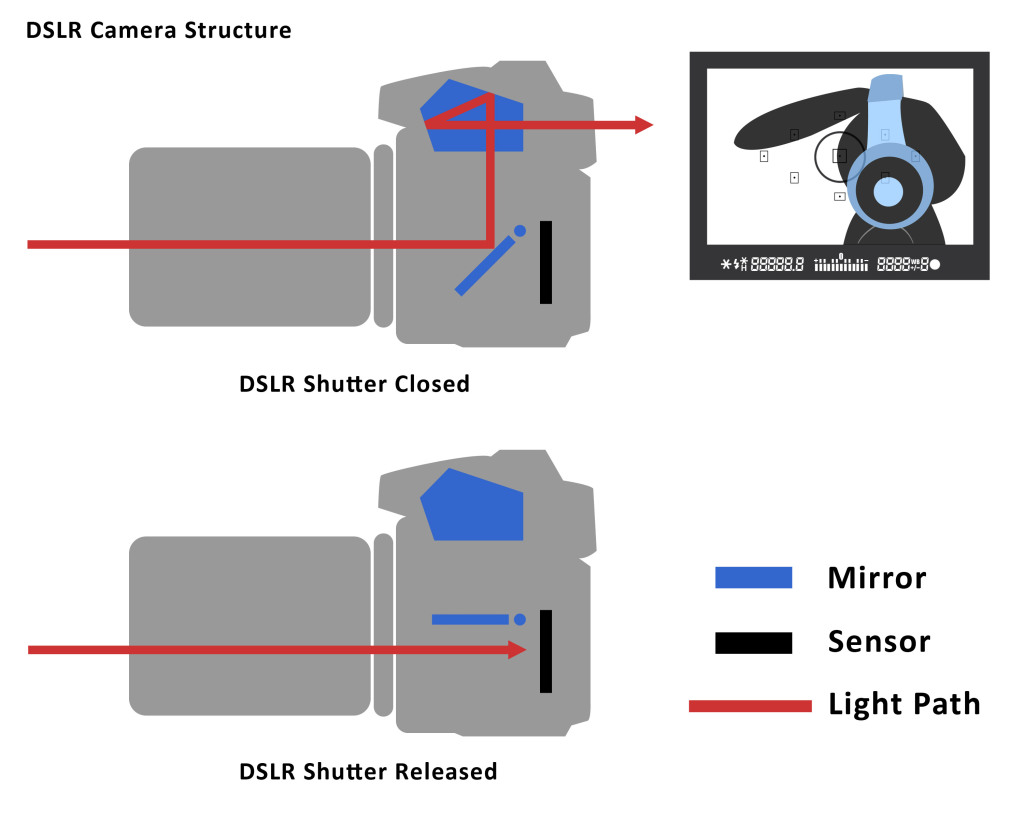DSLR is abbreviation of “DIGITAL SINGLE-LENS REFLEX “. It uses the mirror mechanism to capture the image unlike point n shoot which uses films instead.
DSLRs uses a Mirror, called Penta Mirror inside it to either redirect light coming from lens to viewfinder (what is Viewfinder, explained here) or let the light travel all the way to digital image sensor directly, skipping mirror. DSLR cameras are just the successor of SLR cameras with Digital Image sensor. It uses the same mirror mechanism to take pictures.
Below picture depicts working mechanism of SLR and Mirrorless cameras:
There are various parts of DSLR camera like lens, reflex mirror, shutter, image sensor, pentaprism and many more. I have tried to list out all these parts here (DSLR Parts).
In DSLR light travels from lens opening and reaches the mirror (Penta Mirror) which in turn hits another mirror with specific angle, and the resulting image can be seen through viewfinder. The viewfinders on DSLRs are large enough to see everything through it very precisely, even if you are focusing @500mm distant object with telephoto lens.
Penta-Mirror is quite helpful in tracking of moving subjects and predictive/continuous autofocus. It helps you to see exactly what the camera “seeing” through viewfinder i.e WHAT YOU SEE IS WHAT YOU GET, it helps you tremendously to compose image and adjust/change you focus on subject.
You can also compose the shot using viewfinder without turning your camera ON while this is not possible with Point n Shoot cameras. So that small mirror saves lots of battery too 🙂
Now when we half press the shutter, using that mirror DSLR locks the focus. And once you press the shutter further, mirror flips up and allows light to directly reach the sensor through lens. Sensor captures all the details and displays the final result on LCD.

WHY DSLR :
Better Picture Quality :
No matter how amazing technology gets, there are some fundamental limitations that will more or less always be in the way of point n shoot and smartphones camera. Larger sensors are, in general, better sensors. They can gather more light and offer more depth of field control and with that large sensor you can get images that are practically impossible with a phone.
Those small sensors, even with an f/1.7 lens, cannot offer great DOF control or Bokeh effect which everyone today is aware of 🙂 this term was meant for DSLR only earlier.. 😛
Interchangeable lens :
Interchangeable lenses gives the DSLR quite an advantage over the point and shoot camera, because these extra lenses give DSLR the ability to adapt to any specific requirement. Like suppose if you want to shoot wildlife then obviously 18-55 kit lens is not enough, here you can interchanges your lens with any longer focal length lens like 75-300mm, same way for portraits or low light conditions you can use prime lenses when bigger aperture opening.
Better Light Sensitivity :
Even a entry level DSLR now a days has good ISO range upto 6400, which is quite helpful to shoot pictures in lowlight condition.
Shutter Speed and Focusing:
DSLRs gives you flexibility to continuously focus on subject if subject is in action like running shot or Formula One photography. With higher shutter speed you also get burst mode to take multiple shots within seconds. Same way you can use slow shutter speed to shoot light trails, silky water effects or blurry photos like panning photography.
Manual Mode:
You will have full control on your camera in manual mode. You can change the setting like aperture, shutter speed, white balance or ISO as per your need.
Now there are some disadvantages too like its Price tag as compare to Point n Shoot, size and weight and complexity too.
keeping all this in mind, you should only invest in DSLR if :
First and foremost, You are willing to learn photography not just for time pass thing.
You should start with mobile photography and then switch to DSLR.
You can invest considerable amount of money into DSLR and its lenses.
You can weighs advantages and disadvantages, and then decide where you are inclined to.
Keep Clicking 🙂
Please share the article if you like it.